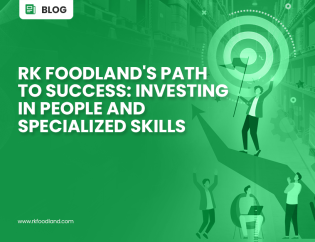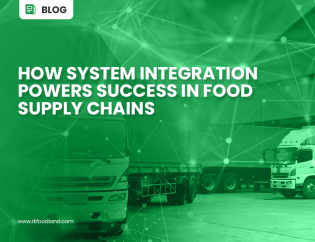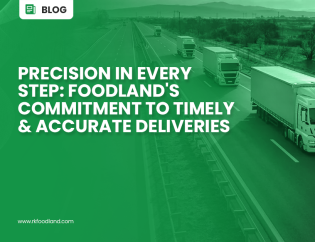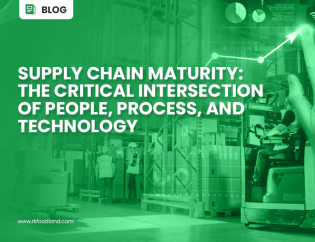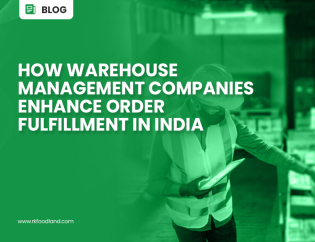
[Avg. Read Time < 4 mins.]
Imagine this: You are eagerly waiting for your favourite burger at a fast-food chain. The moment it arrives, you notice something is off. The lettuce is not crisp, the patties are not as flavourful, and the overall experience is underwhelming. What went wrong? The answer often lies in a journey that is overlooked – the journey of the food across the supply chain. In food industry, effective transportation management is not just about moving products; it is a balancing act between cost efficiency and service excellence.
This is especially critical in the food service supply chain, where the stakes are high due to factors like perishability, temperature sensitivity, and stringent safety regulations. Each ingredient carried through this supply chain holds a story of complex logistics and meticulous care. It is a journey where the freshness of lettuce, the quality of the patties, and the safety of the meal hinge on the effectiveness of transportation management. This blog dives into complexities of managing costs while ensuring service excellence in food transportation, a key ingredient in the success recipe of food industry.
The Critical Role of Transportation
Transportation of goods in the food industry is far more than simply moving items from point A to B; it’s a nuanced science integral to product integrity and the overall success of the supply chain. This process is underpinned by several key factors:
- Implementation of Stringent Protocols: Essential for handling perishable goods, ensuring they reach their destination in optimal condition.
- Multi-Temperature Vehicle Capabilities: Offering a range of transportation solutions, such as multi-temperature vehicles, to cater to the diverse needs of various food products.
- Advanced Technology Utilization: Technologies such as temperature monitoring sensors and GPS are central to maintaining ideal conditions during transit. These are not just tools, but guardians of quality, ensuring precise calibration for the goods transported.
- Regular System Maintenance: Essential for ensuring the reliability of key technologies like temperature controls and GPS tracking. This maintenance goes beyond routine checks; it’s critical for maintaining the equipment’s functionality and upholding customer trust in the brand’s ability to consistently deliver high-quality products.
- Precise Scheduling and Route Optimization: Crucial for timely deliveries, a key factor in maintaining trust, especially important in the food service and FMCG sectors.
- Compliance with Regulations: Understanding and adhering to food transportation regulations, including maintaining necessary documentation and legal clearances, is non-negotiable for smooth, uninterrupted delivery services.
In essence, transportation is a complex yet indispensable part of the supply chain, critical in upholding product quality, regulatory compliance, and ultimately impacting the bottom line.
The Pitfalls of a Cost-First Approach
Opting for a cost-first approach in food transportation can be a short-sighted strategy with far-reaching consequences, often overshadowing the initial savings with long-term financial and reputational losses. When businesses prioritize cutting transportation costs at the expense of quality, they inadvertently set off a domino effect that impacts the entire supply chain. For example, choosing cheaper transportation options might lead to inadequate temperature control, resulting in spoilage of sensitive food items. According to the Food and Agriculture Organization, approximately 14% of the world’s food is lost before reaching the retail level, much of which can be attributed to improper transportation and handling.
Moreover, a cost-focused mindset can strain the relationships with transportation providers. Prioritizing low-cost services often leads to partnering with providers who may not invest in quality vehicles or proper training for their staff. This can result in a higher incidence of damaged goods and delays. The fallout from such service failures is not just limited to immediate waste and cost implications but extends to customer dissatisfaction. A survey revealed that nearly 61% of consumers would switch to a competitor after just one bad experience, indicating the high stakes involved.
A cost-first approach also tends to overlook indirect expenses that accumulate over time. These include the costs associated with returns, additional customer service management, and handling customer complaints – all of which can be significantly higher than the initial transportation costs saved. For instance, a study indicated that for every dollar saved in transportation, businesses could incur up to $7 in indirect costs due to reduced product quality and customer dissatisfaction.
In conclusion, while managing costs is a critical aspect of business strategy, it’s crucial to balance it with a value-based approach in food transportation. This means investing in quality transportation services, fostering strong relationships with providers, and considering the broader implications of transportation decisions on the entire ecosystem, from farm to table. By doing so, businesses can ensure not just the integrity of their products, but also the satisfaction and loyalty of their customers.
Rewards of Service Excellence
Shifting from a cost-centric to a service excellence approach in food transportation ushers a realm of advantages, pivotal for both value creation and operational maximization. This strategic pivot, emphasizing elements like OTIF (On-Time In-Full) delivery, meticulous scheduling, and upkeep of optimal transport conditions, plays a key role in augmenting operational effectiveness. This focus on service excellence transcends beyond mere logistics; it becomes a tangible reflection of the business’s commitment to reliability and quality, crucial in fostering long-term partnerships and trust with other businesses.
1.On-Time In-Full (OTIF) Delivery:
- Ensuring right products are available in right quantity, at the right time when and where they’re needed. A study by the Food Marketing Institute found that a 1% increase in OTIF performance can lead to a 1.14% rise in customer satisfaction.
- For instance, in the fast-paced QSR industry, OTIF is pivotal for keeping menu items available, directly impacting sales and customer experience.
2. Reduction in Wastage:
- Properly managed transportation reduces spoilage and waste. The Environmental Protection Agency (EPA) states that more efficient logistics can decrease food waste by up to 30%.
- In the FMCG sector, this not only translates to direct cost savings but also aligns with growing consumer expectations for sustainability.
3. Maintaining Product Integrity and Quality:
- Service excellence in transportation ensures that products, especially perishables, maintain their quality. According to a report, companies that invested in high-quality transportation reported a 70% decrease in damaged goods.
- For a food service business, this means delivering fresh, high-quality meals to customers.
4. Value Maximization:
- Investing in superior transportation services yields a high return on investment. A survey indicated that companies focusing on service excellence in supply chain operations saw a 20% increase in customer retention.
- Enhanced supply chain reliability and efficiency lead to cost savings over time, outweighing the initial investment in quality transportation services.
It is evident that optimizing transportation management is crucial for maintaining product quality, ensuring regulatory compliance, and enhancing customer satisfaction. It’s an investment that goes beyond mere cost savings. For businesses looking to thrive in this food sectors, overlooking the importance of transportation in the supply chain is not an option.
Are you eager to elevate your food business through superior transportation management?
Connect with RK Foodland’s experts today to explore how transportation services in the food supply chain can drive your business towards unparalleled performance.
Related Content | Foodland’s Resources
Food Transportation Safety: Best Practices for a Secure Supply Chain
Food Chain Safety – The Role of your Transportation Service Provider
Guide To Shifting From Cost-Based To Value-Driven Supply Chain
Efficient Perishable Goods Freight Transportation and Logistics


